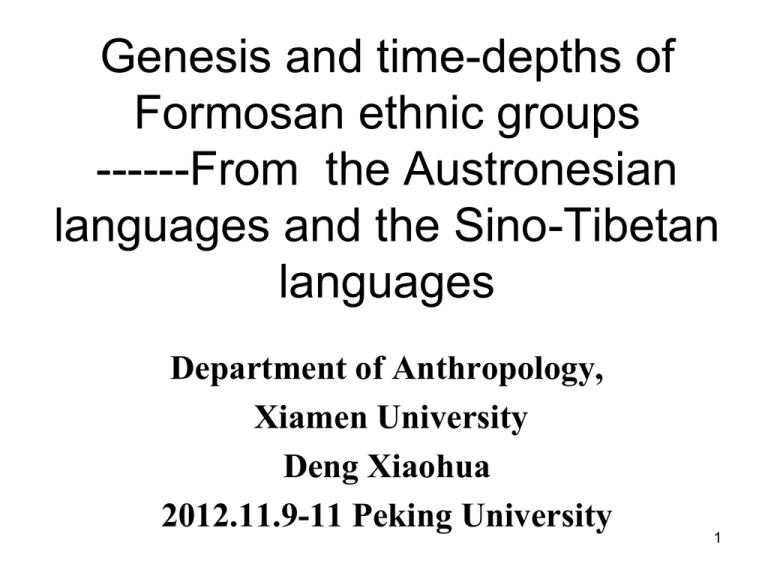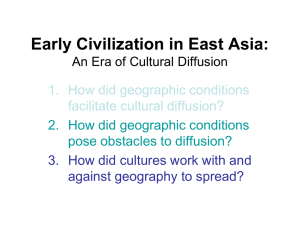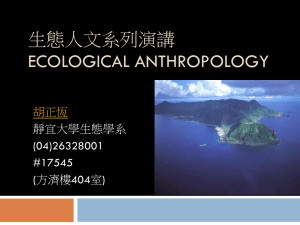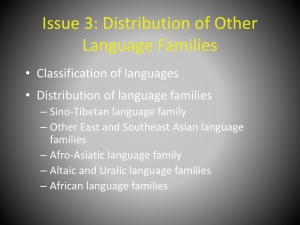Kam-Tai
advertisement

Genesis and time-depths of Formosan ethnic groups ------From the Austronesian languages and the Sino-Tibetan languages Department of Anthropology, Xiamen University Deng Xiaohua 2012.11.9-11 Peking University 1 Study scope: Tibeto-Burman Kam-Tai • Sino-tibetan Hmong-Mien (Miao-Yao) Chinese • Austronesian——Taiwan-centered languages of Pacific islands 2 3 Did Tibeto-Burman originate from Nepal in the Himalayas? Is Nepal the civilized cradle of Tibeto-Burman? (van Driem) 4 5 6 7 • Theoretical basis:the etymological method (the glottochronological method) – In the preliminary study on the relationship between Sino-Tibetan languages, we found that a slightly revised Swadesh 100-word list can be used as the prototype for the comparative research of the genetic relationship between languages. 8 • Two methods often used in the molecular anthropology: The distance- and- feature- based methods • Classification standard and methods: – Swadesh 100-word list and the computational methods 9 Major steps in computational classification: (1) Similarity Matrix – Choose cognates and design cognate vocabulary list,then calculate the retention rate of cognates among lanuages (2) Distance Matrix – Because the distance relationship is indicated by the branch lengths of the mathematical tree diagram, so the similarity matrix should be coverted to distance matrix. 10 • Research purpose – Aims to provide a scientific identification of the genetic relationship and the time depths of the languages and dialects of Sino- Tibetan family. 11 • The study, based on cognate database, aims to explore the classification of the genetic relationship between the languages and dialects of Sino-Tibetan family and measurement of their timedepths, with the computational method, the Phylogenetic methods in molecular anthropology and the etymological statistics. 12 Having made prominent achievements in human origins, the computational phylogenetic methods ,used for identifying the classification of the genetic relationship between human species, can be applied to studies of linguistic evolution, exactly, the classification of the genetic relationship among languages and their time-depths. 13 • Some of the main research concerning this interdisciplinary field ( such as IndoEuropean, Austronesian) have been published in Science, Nature, Proceedings of the National Academy of Sciences etc. (Gray & Fiona 2000, Gray & Atkinson 2003,Gray et al.2009). • And these research mainly uses Swadesh 100-word list as the basis for cognate calculation (Hamed & Wang 2006). 14 Genesis of Formosan ethnic groups Have Formosan ethnic groups a separate origin? Mainstream viewpoints in Taiwan: Austronesian peoples originated separately in Taiwan and diffused to the Pacific islands, so Taiwan is the homeland of Austronesian peoples. • The research seems exploited by politics. 15 Genesis of Formosan ethnic groups Have Formosan ethnic groups a separate origin? • Paul Jen-kuei Li: the Austronesian race originated in Taiwan, and have no genetic relationship with Kam-Tai in the Chinese mainland, even without contact. (1997,1999,2001). – Sapir’s drift as the evidence 16 Genesis of Formosan ethnic groups Have Formosan ethnic groups a separate origin? • Li(1999) proposed problems under suspicion: – • Why didn’t Austronesian races exist in the Chinese mainland? – Why didn’t Hmong-Mien (Miao-Yao) and Kam-Tai races disappear with sinification, if it explained by sinification? – Some similarities in part of Chinese and Formosan vocabulary can not establish the systematic sound correspondences, so it is considered as the results of borrowing. The results of the molecular anthropological research in Maxie Hospital of Taiwan support the above-mentioned conclusion. 17 • • Genesis of Formosan ethnic groups mainly involves the interdisciplinary research of the molecular anthropology, linguistics, archaeology, ethnography and so on. The studies of linguistics (Deng Xiaohua) and of the molecular anthropology (Jin Li, Li Hui) show that:the indigenous peoples of Taiwan and the Malay both originated from Zhuang and Dong ethnic groups of Mainland China, but have different processes of evolution. So the Tai-speaking people could not be excluded from Austronesian population. Formosan races have closer relation to Kam-Tai races of Mainland China than Malay ethnic groups in the South Asia. 18 Linguistic anthropology:My research 1. Major linguistic approaches to homelands: – linguistic paleontology: utilize cognates to reconstruct geographical environment. – Drift( Sapir): homeland of races is the area where languages diverged from the main stock – Toponymy (study of place names)---same place names share common experience 19 Linguistic anthropology:My research • From a linguistic perspective, the universal adaptability of these methods has been doubtable. – Take the Min and Hakka for example. The Min and Hakka dialects were diverged early from the proto-language, and the Min and Hakka dialect areas have been highly divergent from other. And so is Fujian the proto-homeland of Chinese? It is obviously inconsistent with historical facts. 20 Linguistic anthropology: My research 2. As a matter of fact, numerous powerful non-Han ethnic groups in Chinese history “disappeared” or became minor ethnic groups for sinification. The definition of “nationality” in China, especially identification of the Han nationality is not greatly related to the physical makeup, gene and language, so should be mostly understood it from the perspective of cultural identity. 21 Linguistic anthropology:My research 3. According to Greenberg’s research on American Linguistic Classification,the cognates in conformity with the rigorous sound correspondences between the languages can not reflect completely the origins and the evolution direction of languages. 22 Linguistic analysis of cognates • Differed with Jen-kuei Li , we hold the view that there is the genetic relationship between KamTai and Austronesian with some basic vocabulary as evidences . • Rigorously examined the data, we find that the cognate ratio between Kam-Tai and Austronesian is quite high in Swadesh 100-word list. Eg. Swadesh 100-word list: sun, moon, rain, fire, paddy fields, water, night, leaf, head louse, horn (cattle horn), tail, eye, nose, mouth, teeth, tongue, hand, foot, belly, blood, meat (muscle), bone, road , name, know, bite, eat, die, fly, come, stand, new, red, black, green, I, you, this Yakhontov 35-word list: salt, wind etc. 23 24 • This study compares the reconstructed protoAustronesia cognates recognized by a number of linguistic experts of Austronesian ( Dempwolff 1934,1937,1938; Dyen1971; Dahl1973; Blust1980,1983-84,1988,1989 etc.) to the proto- Kam-Tai cognates reconstructed by Li FangKuei etc., in order to identify and explain the genetic relationship between them. (PAN for proto-Austronesian;PA for proto-Atayal ;PMP for proto-Bahasa Melayu ;PP for proto-Paiwan ;PFN for proto-Formosan-Austronesian;AA for protoAustronesian;PT for proto-Kam-Tai ;PTB for proto-Tibeto-Burman) 25 1. moon,PAN *bulal; PA*bural; Zhuang dɯːn¹; Daixi dɤn¹ ;Daide lən⁶;Dong naːn¹; Li naːn¹;PT*ʔmblɯen。 2. rain,PAN *quzan; Zhuang fɯn¹;Daixi fun¹; Dong pjən¹;Li fun¹;PT*p-run。 3. fire,PAN *sapuy; PA*hapuy; Zhuangfei²;Daixi fai²;Dong pui¹;Li fei¹;PT*pui。 4. paddy fields,PAN qumaɦ;PA quma; PMP*tanah;Zhuangna²;Daixi na²;Li ta²; PT*na。 5. water,PAN *jalum; PA*zalum; Zhuangɣam⁴ Daixi nam⁴ Dong nam⁴ Li nom³ PT*nam。 6. eye,PAN maca;PAmaca;PMP*mata; Zhuangta¹;Daixi ta¹;Dong ta¹;Shui da¹;Li 26 tsha¹;PT*pra。 7.nose,PMP*hiduŋ;Proto-Cham *ʔiduŋ; Zhuang daŋ¹;Daixi daŋ¹;Dong naŋ¹;Shui ʔnaŋ¹;PT*q-diŋ。 8.mouth,PAN *baqbaq; Proto-Cham *babah; Zhuang paːk⁷;Daixi paːk⁹;Shui paːk⁷;PT*Cbak。 9.teeth,PAN *(ŋ)ipən;Zhuang fan²;Dong pjan¹;Li fan¹; PT*plan。 10.tongue ,PAN *dilaq;Sanya-Hui la⁵⁵;Paiwan səma; Zhuang lin⁴;Daixi lin⁴;Dongshui ma²; Li ɬin³; PT*lin; *ma。 11.hand,PAN *lima;Zhuang fɯ²;Daixi mɯ²; Dong mja²;Shui mja1¹;Li meɯ¹; PT*mwiɯ 27 Analysis of cognates: dog Dog in ancient Chinese literature: 1)Shuo Wen: sou 2) The Book of Songs: lu 3) Shuo Wen: mang 28 Analysis of cognates: dog 1)Shuo Wen: sou “南越名犬夔獀” Kuisou, a famous canine in Nanyue. ---《说文》 ---Shuo Wen Dog: Proto-Austronesian:*wasu Tagalog: a´so, Huihui:Öa42 sau33 29 Analysis of cognates: dog (1)Shuo Wen: sou The second syllable of Proto-Austronesian form corresponds to sou, so it is no doubt that ther is homologous relation. Norman, Jerry and Tsu Lin Mei(1976) believe that sou is a Chinese borrowed word from Austro-Asiatic languages. But we take this word as an Austronesian word, for Nanyue and Austronesian race share the system of culture at least before the Neolithic Period. 30 Analysis of cognates: dog (2) Shiji(the Book of Songs): “lu” “卢令令,其人美且仁”。毛传:“卢,田犬”。 Ling-ling go the hounds; Their master is admirable and kind. -----Luling, Qifeng, Shiji Li Fang-Kuei * ljag,dog”, Hmong Yang Hao l†a3, Hmong Gaopo tl†æ3,Biaomin-Yao klu3,Mian-Yao ku3,Mian Luoxiang klo3,Jiongnai kla3; Wang Fushi,Mao Zongwu * qlAu. 31 Analysis of cognates: dog 2)Shiji( the Book of Songs) : “lu” Austra-Asiatic :VN cho‚;Palaung sh„;Khum, Wa soÖ;Kharia s„´l„Ö; Ju solok; Gutob,Pareng,Remo guso;Khasi ksew;Mon kluw; Old Mon cluw;Khmer chkÆ. A. Haudricourt:VN ch- < kl-。 Therefore, lu in Shiji has genealogical relation with dog in Austronesian and Hmong-Mien. 32 • According to Sagart’ s study, u()kuq (dog) in the original Hesperonesian MalayoPolynesian is homologous with dog in Chinese * kroÖ * kuÖ. compare to Formosan: Zou Yu*- kuqabÖu。 Dah-an Ho *kukur Two different origins:Sino-Tibetan and Austro-Asiatic 33 (3) Shuo Wen: mang “南昌谓犬善逐兔草中为莽” In Nanchang, the dog good at catching rabbits is called mang. -------Shuo Wen Li Fang-kuei(1977) Proto-Tai: “gou” →hmaA1 Kam-Tai “gou”: Zhuang ma1;Mulao Çäwa1; Shui mäa1,Thai ma5; Dong Bei kwa1;Gelao mpau1;Hlai pou1; Bigong qew2;Qiaoshan qwau2; 34 (3) Shuo Wen: mang It is noticeable that the main residents are Yue people in Nanchang county before the Han Dynasty, and their descendants the Zhuang and Dong clans in the Tang and Song Dynasty. Different linguistic forms of dog and distribution show that the 5 language groups in the East Asia( Austronesian, Sino-Tibetan, Kam-Tai, Hmong-Mien and Austro-Asiatic) share Isomorphism and heterogeneity 35 • Similar examples: crossbow , paddy field, wind, foot, thunder, pig, paddy rice, rice, fire, road, salt, Shaman etc. • “nu”,PAN:*panaq; • Archaic Chinese(LFK)*na,AA:VN na’; Proto-Mnong *sóna;Proto-Tai *hna ; Proto- Hmong-Mien *n̊Ak。 36 Analysis of cognates: paddy field • • • • • • • • PAN*qumaɦ Paiwan( Ferrell,1982) *pana Western Malayo-Polynesian (Dempwolff) *bena; Proto-Tai *naA; AA *lioŋ; Proto-Hmong-Mien *ljiːŋ; Chinese:“ru, low wetland”: *na Tibetan, Kachin: na,“grassland, lowland, meadow” 37 Analysis of cognates: wind • PFN:*bali; Proto-Tai: *dluom; Archaic Chinese (LFK):*pjêm “飛廉”(feilian): frequently used in literature of Archaic Chinese. “前望舒使先驅兮,後飛廉使奔屬。” “The pale moon’s charioteer I then bade lead, The master of the winds swiftly succeed” ----Li Sao, The Song of the South Feilian is the transliterated word of proto- Austronesian “feng (wind)”. (Deng 1994) 38 The homogeneities in different aspects shared by 5 language groups in the East Asia 1) of the primitive Mongoloid: eg. fire, smoke, pig, road, bone, bird, head etc. 2)of Southern Mongolian (Malayan) eg. dog, tiger, snake, kill, paddy field, village, shaman (”wu” in North China vs. “tang” in South China), hand, five etc. 39 The homogeneities in different aspects shared by 5 language groups in the East Asia (3)engendered by cultural transmission and diffusion from the Neolithic period Eg. Cognates: horse, dog, crossbow, paddy rice, needle, iron etc. 40 Two models of population expansions and language evolution in East Asia Physical migration and cultural diffusion 1. “express-train” 2. “entangled-bank” 41 Split of Kam-Tai from Austronesian: possible explanations • Punctuated equilibrium (Dixon1997)& Reticulate models (Bellwood1996) – The Qin and Han Empire ruled over almost all Baiyue-Austronesian Baiyue- Austronesian areas in the southeast China, which engendered sweeping changes of the primitive Austronesian, and the state of equilibrium was punctuated . 42 Split of Kam-Tai from Austronesian: possible explanations (cont.) • Punctuated equilibrium (Dixon1997)& Reticulate models (Bellwood1996) – Massive migrations southward resulted in the ascendancy of Han culture from the North China. This may accelerate the sinification of BaiyueAustronesian and triggered Split of Kam-Tai from Austronesian, which is considered as the fundamental reason for Austronesian’ s abruptly disappearing from the Chinese mainland 43 Split of Kam-Tai from Austronesian: possible explanations (cont.) • Complex Adaptive System – Nonlinearity – phase transitions 44 Multi-direction of language diffusion • The traditional view that Austronesian races expanded unidirectionally needs reexamined. • Two routes from recent studies:, a. the southeast coastal area of China (4000B.P.)→Yunnan and the Southeast Asian islands →Taiwan Eg. Cognates shared by Austronesian and AustroAsiatic: paddy rice, crossbow, Shaman “dang”, 45 Multi-direction of language diffusion • Two directions from recent studies:, b. the southeast coastal area of China →Taiwan eg. dog, foot, pangolin etc. This shows that different language forms may have different directions of transmission, namely, drift has no fixed forms. 46 Multi-direction of language diffusion • We hold that Kam-Tai languages have the genetic relationship with Austronesian, but there are still unsettled questions. • Where is the proto-homeland of Austronesian languages? What are their directions of diffusion, from the Chinese mainland or Taiwan to the Pacific islands? 47 Time-depths of Austronesianspeaking group • Generally accepted views of linguistic chronology: Austroasiatic: 6000B.P., the Southwest China Austronesian : 6000B.P.,Taiwan Hmong-Mien: 2500B.P.,downstream of the Yangtse River Kam-Tai: 2500B.P.,the Southeast China Sino-Tibetan: 6000B.P.- 7000B.P.,the middle upper reaches of the Yellow River 48 • The computational Phylogenetic methods to work out the time-depth of language split, are heavily criticized, because it is thought that basic vocabulary , disturbed greatly by Horizontal transmission, is not as stable as genes. • Any scientific method has its limitation. But the method has high reliability, if the results are roughly consistent with the conclusions of other relevant disciplines, such as archaeology, ethnography and so on. [i] Colin Renfrew, April McMahon, Larry Trask eds., Time Depth in Historical Linguistics(2000) 49 Figure1: Language Evolution Tree and Divergence-time Estimates 50 • Note that we adopt the data of protoSino-Tibetan as the rooting node of the tree, because it seems certain that proto-Sino-Tibetan is distantly related with the other 13 languages in this study. 51 • In the 100 words, 8 words in the protoSino-Tibetan have correspond to in Austronesian, fire, horn, eye, blood, fly, salt, wind. Some other core words have a great probability of borrowing, such as paddy field, crossbow, head, hair,belly, snake, road, witchery, horse. 52 • In fact, it is quite different to identify the homologous or borrowing relations of these words. • Zhang Guanzhi and van Driem believe that powerful Longshan Culture (around 6000 B.P. )in North China had deeply influenced the proto-Austronesian culture in the Southeast China. If archaeological conclusions are available,most of these words are loan words, the results of “Northnization”. • Because the genetic relationship between the proto- Sino-Tibetan and the protoAustronesian has been much debated, the data of the proto- Sino-Tibetan just are used for reference. 53 • As figure 1 shows, the time depths roughly accord with the chronology from ethnic history: – Baiyue-Austronesian group came into being in approximately 4000 B.P. in Southeast China; – the Austronesian retreated from the Chinese mainland after the reign of the Qin and Han Empire ; – based on the Hainan indigenes, the Li lineage around 2700 B.P.; 54 • As figure 1 shows, the time depths roughly accord with the chronology from ethnic history: – Lingao splitted gradually from Li around 2,000 years BP, influenced by the Han migration befor the Tang and Song Dynasty; – in the Wei and Jin Dynasty, taken Baiyue as the main body, Li-Liao ethnic groups took shape in about 1900 B.P ; – Zhuang diverged in 900 B.P., and the ancient name of Zhuang, “tongding”, was found in the literature of the Southern Song Dynasty. 55 Conclusion : • Austronesian races lived in the large area around the South China, and began to separate from 4000B.P. and expanded to Taiwan and the Araucaria islands along the Southeast coastal area or the IndoChina Peninsula. • Finally, we attempt to adopt different theories of language evolution to explain the formation process of the East Asian language area, in order to establish a multidisciplinary framework. 56 Theoretical significance • continuity and discontinuity of linguistic traditions • interruptive change of Austronesian in the Chinese mainland • Hypothesis : – It is unbelievable for the family tree model that all have descended from a single ancestral language to make clear the above-mentioned language facts. – In comparison with the viewpoint that a language may has more than one parent,it is a better explanation that in a limited geographic area, different languages with similar structure and forms merge a new daughter language(Dixon,1997) 57 Welcome comments 58







